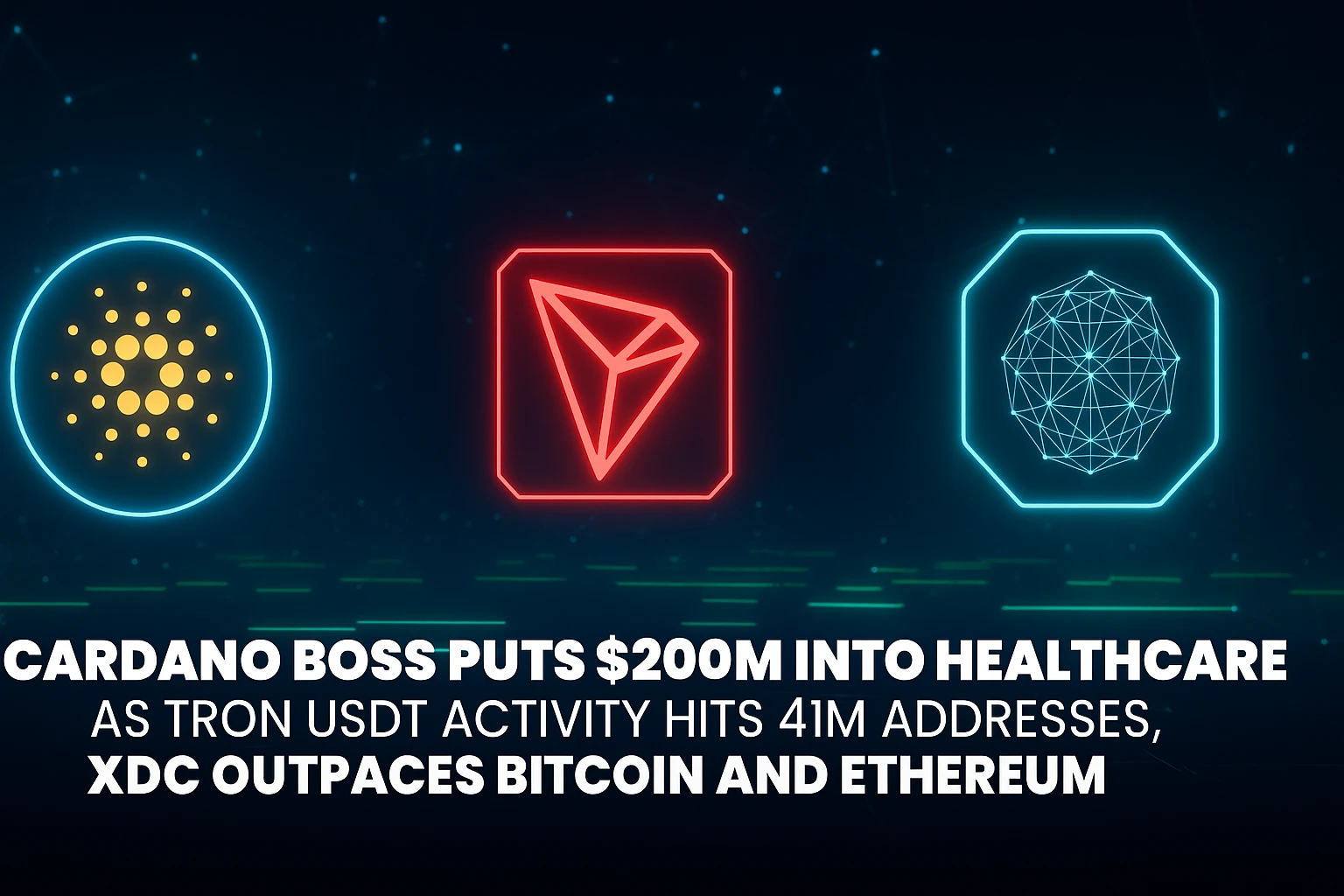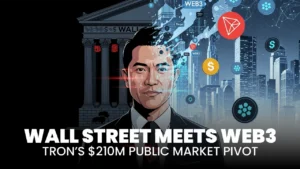Cardano Boss Puts $200M Into Healthcare Amid Top Show By TRON and XDC Network

Three developments are pushing the crypto market’s utility narrative into sharper relief. Cardano founder Charles Hoskinson committed $200 million of personal capital to build and open-source a patient‑first medical model in Wyoming.
- Hoskinson’s $200 Million Bid to Prove a New Care Model
- TRON Extends USDT Lead and Cuts Fees
- XDC Quietly Beats Bitcoin and Ethereum Over 12 months
- The Numbers At A Glance
- Market Reaction and Costs
- Institutional and Community Signals
- Risks and Policy Watch
- Why This Matters to Holders
- Conclusion
- Frequently Asked Questions About TRON USDT Activity
- How many addresses are involved in USDT transactions on TRON right now?
- Did TRON really cut network fees by 60 percent?
- Why is TRON popular for USDT transfers?
- What is the regulatory backdrop for TRON?
- Does any of this affect Cardano or XDC Network?
- Glossary of Key Terms
Whereas TRON extended its dominance in stablecoin rails as on‑chain data showed more than 41 million addresses engaged in Tether transactions and governance approved a 60 percent network‑fee cut. RSA XDC Network quietly outperformed Bitcoin and Ethereum over the past year, helped by institutional steps such as a Kraken listing and a planned USDC rollout.
Together, they highlight how design choices such as Delegated Proof of Stake (DPoS) are translating into throughput, lower fees, and growing institutional bridges, even as regulatory scrutiny remains.
Hoskinson’s $200 Million Bid to Prove a New Care Model
In a blunt interview at the Rare Evo conference, Hoskinson criticized US health care incentives and said his Wyoming medical center, now serving roughly one-third of Gillette’s population, is meant to demonstrate cheaper, more humane care with AI support and selective blockchain tools.
He said he has invested $200 million, will open-source the stack, and will not charge patients who cannot afford to pay. The clinic operates on a pay-what-you-can ethos and explores privacy-preserving cryptography for records where it adds value.
An Australian outlet summarized the remarks and the funding figure while noting Hoskinson’s plan to make the software stack freely available. The reporting aligns with CoinDesk’s interview, which included the same dollar commitment and the intent to open source.
While Cardano itself operates on Delegated Proof of Stake (DPoS), the clinic initiative highlights a broader trend visible across the crypto industry this month. Networks that can ship low‑cost, high‑throughput rails are attracting real‑world activity. That makes governance design relevant for health‑care data flows as much as for payments, even if medical systems demand stricter privacy and compliance than open DeFi rails.
TRON Extends USDT Lead and Cuts Fees
TRON’s stablecoin gravity remains firm. A new analysis highlighted that more than 41 million addresses are now transacting in Tether on the network, underlining why exchanges and payment apps default to TRC‑20 transfers for speed and cost. The stat was flagged by on‑chain analysts on X and picked up in trade press coverage.
Network governance then moved to preserve fee competitiveness. Founder Justin Sun announced that Super Representatives approved a 60 % fee reduction, effective August 29. He framed the cut as a short‑term hit to profitability that should expand users and transactions.
TRON also led peers in daily active addresses around the start of September, with third‑party trackers citing about 2.48 million active addresses. Fee policy changes and persistent USDT flows likely contributed to that leadership.
Regulatory context still matters. Earlier this year, Reuters reported that the US The Securities and Exchange Commission and Sun were exploring a resolution to the agency’s civil complaint.
The case outcome remains uncertain, but the engagement itself is a reminder that large stablecoin rails and DPoS governance will stay in the policy conversation.
XDC Quietly Beats Bitcoin and Ethereum Over 12 months
While the biggest headlines focused on blue chips and ETFs, XDC posted the better trailing performance. Over the last 12 months, XDC rose roughly 206 % compared with about 109% for Bitcoin and 93% for Ethereum, according to a September 9 analysis referencing CoinMarketCap data. As of this week, XDC traded around 0.079 to 0.080 dollars.
Institutional bridges tightened. Kraken listed XDC on September 2, increasing US access through a top exchange. Later in August, Circle and the XDC Foundation announced that native USDC and CCTP V2 are coming to the network, a step that can simplify regulated dollar settlement for tokenized trade‑finance flows. Both moves are directly relevant to real‑world asset pipelines and to market makers that prefer fiat-on-chains with predictable redemption.
XDC’s technical profile helps explain the traction. The chain uses a Delegated Proof of Stake (DPoS) variant often referred to as XDPoS, designed for low fees and seconds‑level finality. In markets where cost‑to‑transact determines user behavior, DPoS systems that compress validator sets and align incentives through delegation have continued to capture payment and enterprise pilots.
The Numbers At A Glance
| Item | Verified figure | Date |
| TRON addresses engaged in USDT transactions | 41 million plus | Sep 10, 2025; Sep 2025 |
| TRON network fee change | 60 percent cut effective Aug 29 | Aug 29, 2025 |
| TRON daily active addresses | About 2.48 million | Sep 1, 2025 |
| XDC 12‑month price change | About 206 percent | Sep 9, 2025 |
| Bitcoin 12‑month price change | About 109 percent | Sep 9, 2025 |
| Ethereum 12‑month price change | About 93 percent | Sep 9, 2025 |
| XDC listing on Kraken | Trading went live on Sep 2 | Sep 2, 2025 |
| USDC and CCTP V2 on XDC | Announced, coming soon | Aug 26, 2025 |
| Hoskinson clinic investment | $200 million personal capital | Sep 9, 2025 |
| Patients served by the clinic | Roughly 15,000 | Sep 9, 2025 |
Market Reaction and Costs
The fee cut on TRON arrived alongside already strong usage metrics. In the 24 hours around implementation, reporting showed TRX trading slightly lower, suggesting the move was framed as a policy adjustment rather than a catalyst. That said, lower marginal costs can reinforce USDT’s network choice and are likely to keep P2P and remittance flows anchored on TRC‑20.
XDC’s trailing performance outpaced majors, and near‑term pricing cited in coverage sits just under eight cents. With the Kraken listing and planned USDC support, market makers and regional exchanges will find it easier to warehouse and hedge inventory. For tokenized‑trade pilots, fewer bridge hops and fiat redemption predictability can lower operational risk.
Cardano’s token did not feature in these performance pieces, and Hoskinson’s clinic is not positioned as a driver of ADA price. The market story here is reputational and infrastructure‑adjacent rather than token‑linked. The initiative’s emphasis on open source and privacy‑preserving proofs points to a cautious, use‑case‑first approach rather than a direct monetization effort.
ALSO READ: TRON Takes the Lead as US Economic Data Makes Debut on Public Blockchains
Institutional and Community Signals
The Kraken listing for XDC signaled a cleaner path for US access. Announcements around native USDC and CCTP V2 coming to XDC point to tighter fiat‑on‑chain settlement and simpler cross‑chain flows. Those are institutional on‑ramps, not just marketing wins.
On TRON, community discussion centered on the scale of USDT activity and whether fee cuts would extend the lead. On‑chain analytics accounts emphasized the 41 million‑address milestone for Tether transactions, while governance messaging amplified the fee decision.
Tweet: CryptoQuant flagged the USDT address surge on TRON
Read the complete analysis ⤵️https://t.co/8oc82srfol
— CryptoQuant.com (@cryptoquant_com) September 8, 2025
Tweet: Justin Sun confirmed a 60 percent fee reduction effective August 29
On August 26, 2025, the Tron Super Representative community proposed to reduce Tron network fees by 60%. This is the largest fee reduction since the founding of the Tron network. The proposal has already passed and will take effect at 20:00 (GMT+8) this Friday!
Here’s my view on…
— H.E. Justin Sun 👨🚀 (Astronaut Version) (@justinsuntron) August 29, 2025
Risks and Policy Watch
Stablecoin rails will remain under the microscope. Even as on‑chain volumes rise, TRON’s founder remains in dialogue with US regulators about past allegations, a reminder that policy outcomes can alter network economics. For XDC, native USDC support will attract more regulated participants and, with that, more oversight.
For Cardano, a health‑care tech stack that touches patient data raises compliance and licensing questions that the open‑source plan will need to navigate. Delegated Proof of Stake (DPoS) may help payments scale, but compliance burdens migrate with the fiat value flowing through those rails.
Why This Matters to Holders
Across three different stories, a single theme connects the market impact. A utility that reduces friction tends to accumulate users and liquidity. DPoS networks have been the default for low‑cost transfers. Institutional bridges, such as a top‑tier listing and native USDC, are feeding liquidity into those rails.
Meanwhile, high‑profile founders are testing crypto’s credibility in real‑world systems. For diversified portfolios, this supports a thesis where payment chains monetize throughput, enterprise chains court regulated dollars, and founder‑led projects explore adjacent markets.
Delegated Proof of Stake (DPoS) will remain part of that conversation because it sits at the crossroads of cost, governance agility, and validator concentration.
Conclusion
The week’s developments show a split screen. TRON’s DPoS governance tightened its grip on stablecoin transfers, cutting fees as USDT usage scaled to tens of millions of addresses. XDC’s DPoS variant delivered a better 12‑month chart while adding institutional rails through Kraken and a planned USDC integration.
Hoskinson’s $200 million clinic project pursued a different kind of validation, importing cryptography and AI into a live health‑care setting with open‑source ambitions. Each track reinforces the same point. Design choices that lower costs and simplify access are where usage is compounding, and DPoS networks are central to that story.
Frequently Asked Questions About TRON USDT Activity
How many addresses are involved in USDT transactions on TRON right now?
Recent reporting and on‑chain analytics flagged more than 41 million TRON addresses engaged in Tether transfers.
Did TRON really cut network fees by 60 percent?
Yes. TRON’s Super Representatives approved the reduction, which took effect on August 29, according to Justin Sun’s post.
Why is TRON popular for USDT transfers?
Low fees and fast settlement make TRC‑20 the default stablecoin rail on many exchanges and payment apps. The network uses DPoS to keep throughput high.
What is the regulatory backdrop for TRON?
Reuters reported in February that the SEC and Justin Sun were exploring a resolution of the agency’s civil case. The outcome was not decided at that time.
Does any of this affect Cardano or XDC Network?
Not directly. Cardano’s news centered on Hoskinson’s clinic and open‑source health tech. XDC’s momentum relates to DPoS economics, a Kraken listing, and native USDC coming to the chain.
Glossary of Key Terms
- Delegated Proof of Stake (DPoS): A consensus model where token holders delegate votes to a smaller set of validators who produce blocks.
- DPoS: Abbreviation for Delegated Proof of Stake.
- TRC‑20: Token standard on TRON used by USDT.
- USDT: Tether’s dollar‑pegged stablecoin.
- USDC: Circle’s dollar‑backed stablecoin issued natively on multiple chains.
- CCTP V2: Circle’s protocol for native cross‑chain USDC transfers.
- Super Representatives: Elected TRON validators in its DPoS system.
- XDPoS: XDC’s DPoS variant optimized for low fees and quick finality.
- Open source: Software whose code is released for anyone to inspect, use, and modify.
- On‑chain activity: Transactions and interactions that occur directly on a blockchain.




